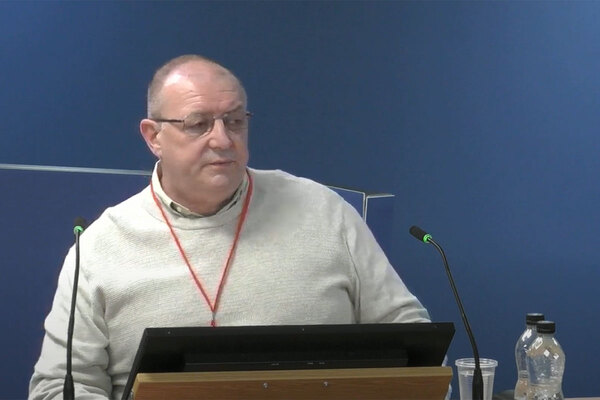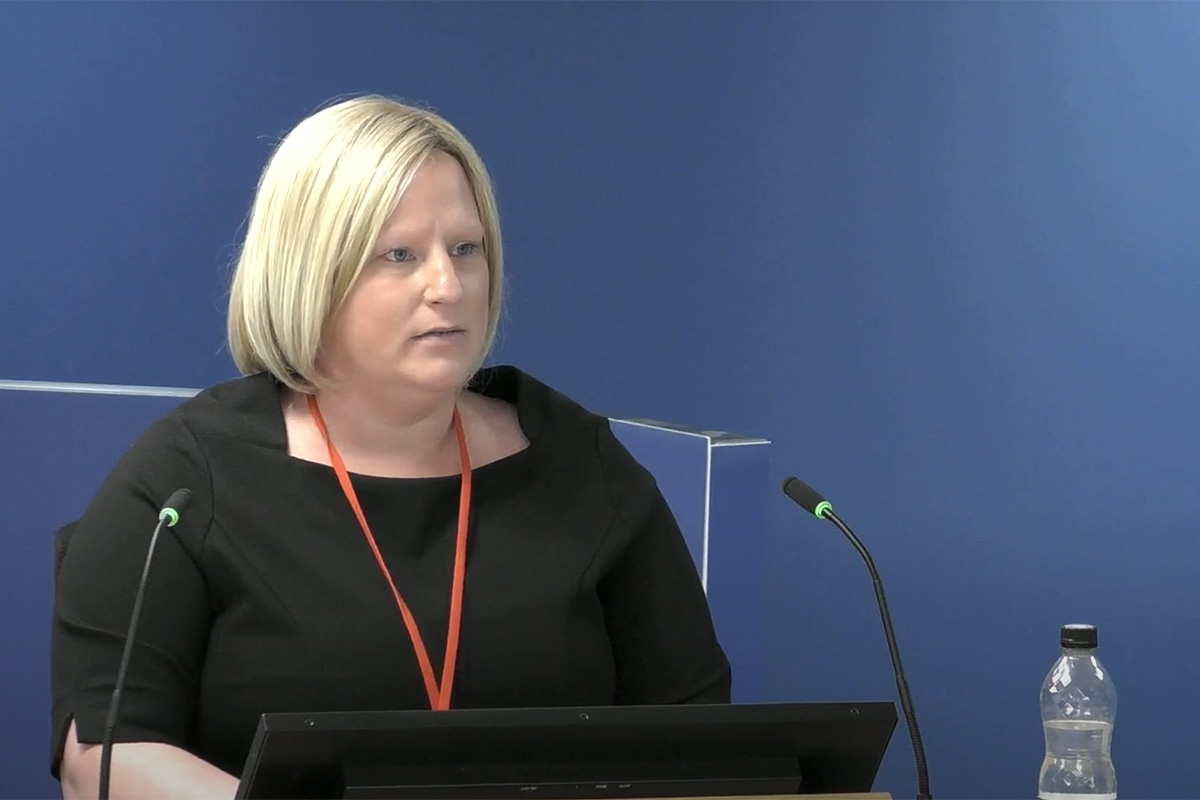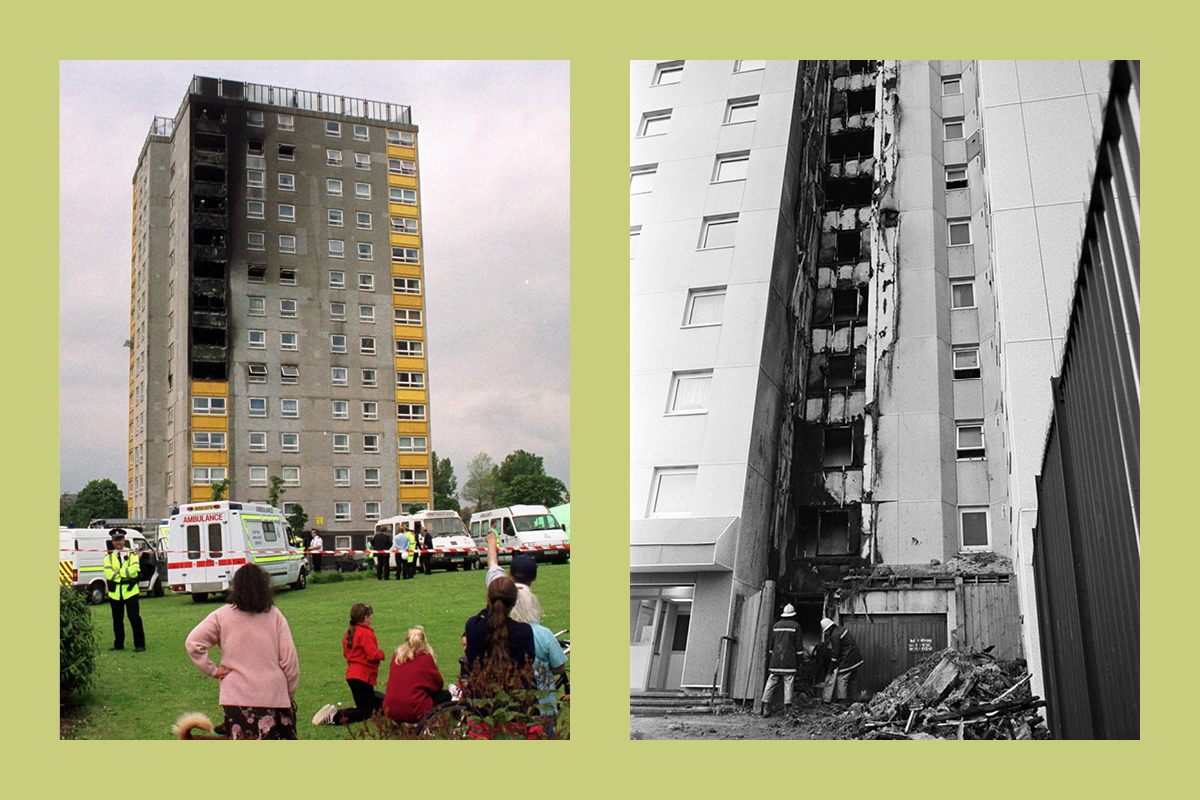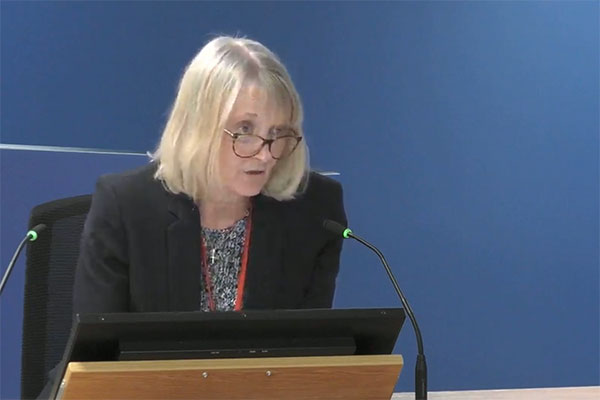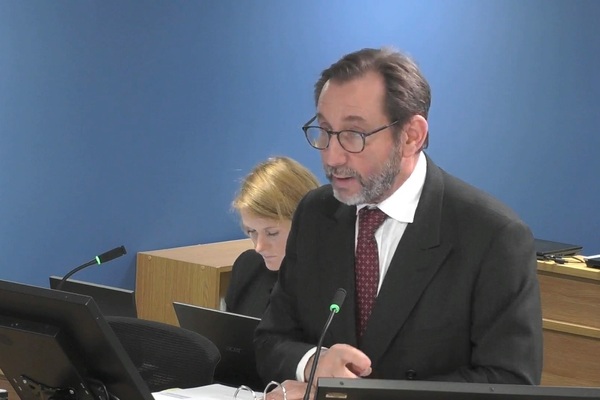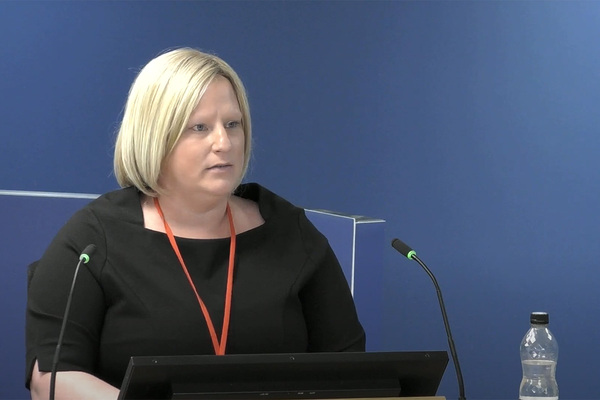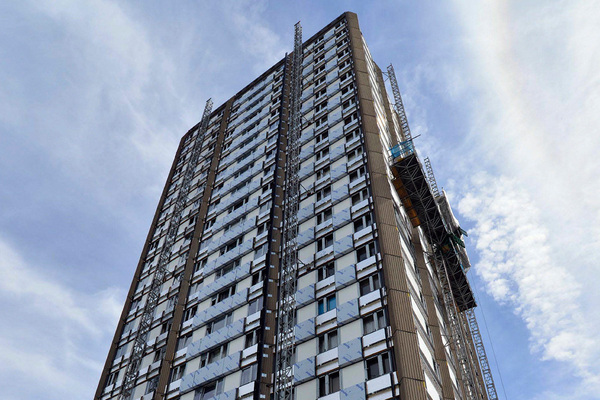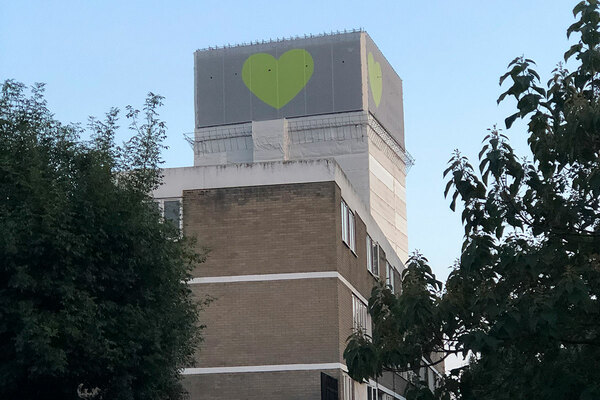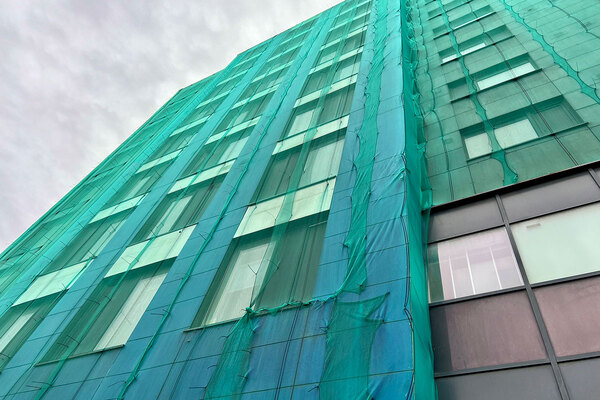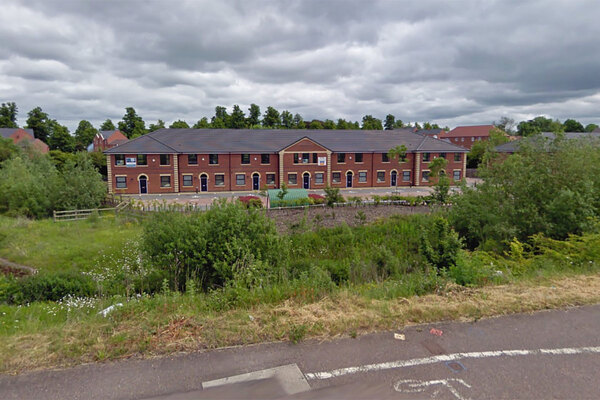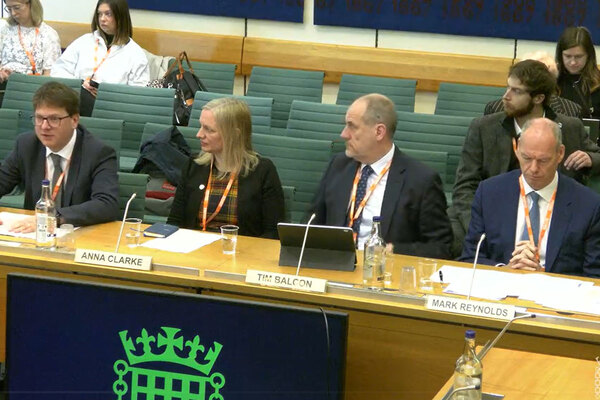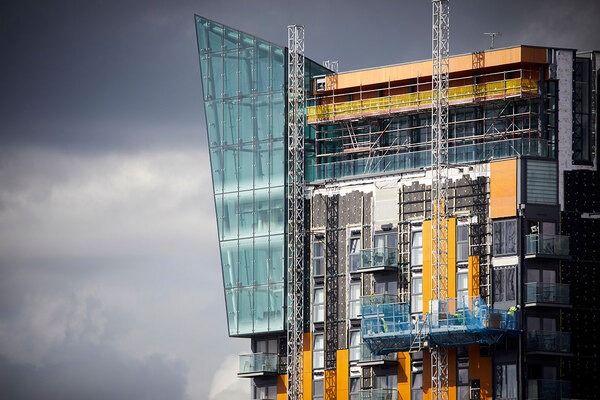Grenfell Tower Inquiry diary week 39: ‘What you said there was a grotesque understatement’
This week the inquiry continued to hear from former employees of Kensington and Chelsea Tenant Management Organisation (KCTMO), as well as two employees from the London Fire Brigade (LFB). Lucie Heath reports
On Monday, the country marked the fourth anniversary of Grenfell Tower fire. The inquiry did not sit on this day as a sign of respect to the victims and survivors.
Tuesday and Wednesday saw the wrapping up of the mammoth five-and-a-half day evidence session from Janice Wray, former health and safety manager at KCTMO, which managed all councils homes in the borough on behalf of the Royal Borough of Kensington and Chelsea (RBKC).
We then heard from two LFB employees who were responsible for overseeing fire safety within Kensington and Chelsea, followed by two KCTMO caretakers who regularly worked at Grenfell Tower.
‘The residents of Grenfell Tower were living in a building with an AOV system which had effectively been condemned as non-compliant’
Last week, Ms Wray (pictured above) was grilled over some of the key recurring issues of this module of the inquiry, including the huge backlog of fire risk assessment actions KCTMO had built up in the early 2010s.
Other areas discussed were KCTMO’s failure to implement a fire door inspection programme as requested by the LFB and the organisation’s failure to create personal emergency evacuation plans (PEEPs) for disabled residents.
This week the inquiry picked up with another major issue from this module: Grenfell Tower’s faulty automatic opening vent (AOV) system, which is used to prevent the spread of smoke in the event of a fire.
We know from previous weeks’ evidence that KCTMO learned following a fire at Grenfell in 2010 that there were issues with the building’s AOV system, however a new system was not installed until 2016. It is believed that this new system failed on the night of the fire in June 2017.
On Tuesday, Ms Wray said she was aware that the system was “old” and “clunky” and we saw evidence of her pushing for budget to have it replaced. However, Ms Wray also denied she was aware of the extent to which the system was failing.
Specifically, she denied ever having seen a 2011 report by KCTMO’s maintenance contractors that stated it could “no longer guarantee that the system will operate as required or that it meets fire regulation”.
Ms Wray claimed her colleagues at KCTMO must not have made her aware of the report. Lead counsel to the inquiry Richard Millett QC said that this was “remarkable”.
“It is now as we sit here but I can only act on the information that I had available at the time,” she said.
We then saw an email sent by Ms Wray to a colleague in 2013, in which she was advising a colleague how to respond to a query sent to him by the Grenfell Tower Leaseholders’ Association (GTLA). The GTLA was asking for an update on various fire safety matters following the 2010 fire at the tower.
The email said: “Works to repair the ventilation/extraction system which were due to commence the following week were progressed and further investigations undertaken on this system to ensure there were no other areas of concern”.
“What you say there was a grotesque understatement and there the residents of Grenfell Tower were living in a building with an AOV system which had effectively been condemned as non-compliant by the maintenance engineers but were doing so in ignorance,” Mr Millett said.
“I can’t dispute that, but I didn’t have that information so I couldn’t have provided it,” Ms Wray said.
‘Why did you allow the TMO to publish perpetually a statement that was erroneous?’
The inquiry then moved on to the topic of the lifts at Grenfell Tower. We already know that various fire risk assessments (FRAs) for the tower incorrectly stated that the building had firefighting lifts – and that lack of firefighting lifts hampered the efforts of the fire brigade on the night of the fire.
A firefighting lift is one that contains certain features that allow firefighters to transport their equipment in the event of a fire. They are required on all buildings taller than 18m.
KCTMO was aware that its lifts were not firefighting lifts. We saw minutes from a meeting in 2010 in which it was agreed that “most of the borough’s lifts meet the majority (but not all) of the criteria which define a firefighting lift”. However, from 2010 onwards, all of the FRAs for Grenfell Tower stated that it did have firefighting lift.
Ms Wray said this was largely due to a disagreement between herself and KCTMO’s fire risk assessor, Carl Stokes, over whether the building had a firefighting lift, with the latter being adamant that it did meet the criteria.
She agreed that the FRAs produced by Mr Stokes were “misleading” and insisted that she “genuinely tried” to stop him from calling the lifts firefighting lifts.
“You did understand did you, maybe you didn’t, that the FRA, although prepared by Carl Stokes as an independent person retained by you, was your FRA. It was the TMO’s FRA,” said Mr Millett (pictured above), to which Ms Wray responded “yes”.
“So if that’s the case, why did you allow the TMO to publish perpetually a statement that was erroneous?”
“I can only reiterate what I said is that he remained very firmly of a view and his view wasn’t shakeable,” Ms Wray responded.
In his witness statement to the inquiry, Mr Stokes said KCTMO provided him with confirmation that the lifts in Grenfell Tower were firefighting lifts. Ms Wray said his statement is “not an accurate reflection of the many discussions we had on this issue over quite a long period of time”.
‘I don’t know why I didn’t spend more time doing that’
This moved the inquiry on to another major theme of the week: the general competence of Mr Stokes as a fire risk assessor.
In previous weeks we had been given glimpses into the fact that the LFB appeared to be unhappy with the service Mr Stokes was providing KCTMO. On Wednesday we heard from two former fire safety team leaders at the LFB, Rebecca Burton (pictured above) and Nicolas Comery, who were both able to provide more insight into the concerns.
As fire safety team leaders covering the Kensington and Chelsea area, Ms Burton and Mr Comery were responsible for a group of people who carried out fire safety inspections in the borough and decided whether enforcement notices needed to be served.
The conflict between Mr Stokes and the LFB seemed to stem originally from the issue of fire doors. We know that in the years leading up to the fire, the LFB was putting pressure on KCTMO to implement a regular inspection programme of fire door self-closers in the borough – something KCTMO was very resistant to due to a lack of resources.
On Wednesday we learned that Mr Stokes had told KCTMO that its current approach to inspecting self-closers, which involved checking them when a property became void or major works were being carried out, had been agreed with the LFB’s head of enforcement. The LFB denied this.
In her witness statement to the inquiry, Ms Burton said she had a meeting with Mr Wray in 2015 in which she was “very frank” with her about Mr Stokes, telling her that “I did not think that he was providing a good service to the KCTMO”.
She told the inquiry that she had expected Ms Wray to “take the concerns to Carl Stokes… and if there wasn’t a change in his approach then I would have hoped that she would have looked for somebody else”.
When asked about this during her evidence session, Ms Wray said she raised had Ms Burton’s concerns with Mr Stokes and that he took them on board.
However, this was not the only time Ms Wray had received a complaint about the FRAs being produced by Mr Stokes.
On Tuesday we heard that an independent fire risk assessor, who had been hired by a Grenfell leaseholder looking to have a stairlift installed, told Ms Wray that the FRA for the tower was “unsuitable and insufficient as the elementary fire safety deficiencies have not been identified by the fire risk assessor”.
Ms Wray said she discussed this complaint with her manager, Barbara Matthews, and that they briefly talked about re-procuring the fire risk assessor role, but that this idea did not take off.
Concerns were raised about Mr Stokes again in May 2017, one month before the fire, when a colleague of Ms Wray’s reviewed multiplied FRAs he had conducted with two health and safety specialists.
Again Ms Wray was told that the FRAs were not “suitable and sufficient” and that the advice given to KCTMO was “completely wrong”.
“Did you take any action at that point to reconsider Carl Stokes’ suitability as a fire risk assessor for the TMO?” asked Mr Millett.
Ms Wray said that she “would have looked in detail at the criticisms”, but that she cannot recall taking any action to ensure the other FRAs carried out by Mr Stokes were reviewed.
It is worth noting that during his evidence session, Mr Stokes said he believed he had always carried out fire risk assessments “to the best of my ability”.
However, this week’s evidence clearly raises questions over why Ms Wray trusted Ms Stokes for such a long period of time despite being given multiple warnings that the work he was producing was inadequate.
We know that just weeks before the fire, Ms Wray turned to Mr Stokes for assurance that the cladding on Grenfell Tower was compliant with building regulations after being sent a letter from the LFB flagging the issue of external fire spread following a fire at another high-rise block in west London.
When asked about this on Tuesday, Ms Wray agreed that Mr Stokes’ response to her query was not “fully informed”.
“Did you not think that this was such a sweeping and unspecific response that it deserved the follow up from you asking the questions I’ve just asked you? What did you ask, who did you ask, what answers did you get and what investigations did you yourself conduct?” asked Mr Millett.
“Yes it did and I don’t know why I didn’t spend more time doing that,” Ms Wray replied.
‘You cover the really important parts and hope, and that was it’
The inquiry finished the week hearing from Paul Steadman and Robert Regan (pictured above), two caretakers (also known as estate services assistants (ESAs)) who had experience working at Grenfell Tower.
Both painted a picture of an increasingly overworked team, which they said was compounded by the fact that KCTMO stopped replacing caretakers that left or retired and instead increased the workload of those who remained.
Part of the caretakers’ job was to carry out weekly health and safety inspections of the blocks within their patch, during which they would input any repairs into a digital system managed by KCTMO.
Mr Steadman said one caretaker would be responsible for roughly 40 blocks and that KCTMO set a time quote of between 30 and 60 minutes to inspect a building, which he said was not enough time for a large building like Grenfell Tower.
Mr Regan’s evidence largely echoed this. In his witness statement to the inquiry, he said: “This did inevitably lead to many jobs getting either left or not raised due to other commitments pushed on to the ESAs… I felt that the ESAs had too much work, which I consider akin to cutting corners.”
“The intention is to cover everything, but that wasn’t always the case. So you cover the really important parts and hope, and that was it. That’s all you can do. What can you do?”
Both Mr Steadman and Mr Regan said these issues were repeatedly raised with managers at KCTMO but that the organisation “didn’t listen”.
At this point it is impossible not to think about the impact of austerity on councils and what this has meant for people working within them. This has been a recurrent theme throughout this phase of the inquiry, with housing officers, building control officers and others explaining how they felt they simply did not have enough time and resources to do their job properly.
The Grenfell Tower Inquiry continues next week.
Grenfell Tower Inquiry headlines: week 39
KCTMO allowed fire risk assessor to incorrectly state Grenfell had firefighting lift
The organisation responsible for the management and maintenance of Grenfell Tower allowed multiple fire risk assessments for the building to state that it had a firefighting lift despite knowing that this was not true.
KCTMO received multiple warnings about competency of fire risk assessor before fire at Grenfell
The health and safety manager at Kensington and Chelsea Tenant Management Organisation received multiple warnings about the quality of the work carried out by the fire risk assessor employed by the organisation, including one complaint just weeks before the fire at Grenfell.
Grenfell caretakers forced to ‘cut corners’ due to time pressures, inquiry hears
Two caretakers who worked at Grenfell Tower have said they were given “too much work”, which led to “cutting corners” and repairs being “left or not raised”.
Grenfell Tower Inquiry phase two: weekly diaries
Module one: the refurbishment
Week one: A vivid picture of a broken industry
After a week of damning revelations at the opening of phase two of the Grenfell Tower Inquiry, Peter Apps recaps the key points
Click here to read the full story
Week two: What is the significance of the immunity application?
Sir Martin Moore-Bick has written to the attorney general requesting protection for those set to give evidence at the Grenfell Tower Inquiry. Peter Apps explains what the move means
Click here to read the full story
Week three: Architects of misfortune
This week saw the lead architects for the Grenfell Tower refurbishment give evidence to the inquiry. Peter Apps runs through the key points
Click here to read the full story
Week four: ‘I didn’t have any perception that it was the monster it’s become’
The architects continued to give evidence this week, outlining a lack of understanding of the fire risk posed by the cladding materials and its design. Nathaniel Barker reports
Click here to read the full story
Week five: ‘No adverse effect in relation to external fire spread’
As the Grenfell Tower Inquiry returns from its long absence, Peter Apps recaps the key points from a week of important evidence from the fire consultants to the refurbishment
Click here to read the full story
Week six: ‘I can’t recall any instance where I discussed the materials with building control’
Nathaniel Barker summarises what we learned from fire engineers Exova, architects Studio E and the early evidence from contractor Rydon
Click here to read the full story
Week seven: ‘I do not think I have ever worked with a contractor operating with this level of nonchalance’
Two key witnesses from contractor Rydon gave evidence this week. Peter Apps recaps some of the key points from a revealing week of evidence
Click here to read the full story
Week eight: ‘It haunts me that it wasn't challenged’
Four witnesses from contractor Rydon gave evidence this week. Lucie Heath recaps what we learned on the last week of evidence before the inquiry breaks for five weeks
Click here to read the full story
Week nine: ‘All I can say is you will be taken out for a very nice meal very soon’
This week the inquiry heard evidence from witnesses at Harley Facades, the sub-contractor responsible for Grenfell Tower’s cladding. Peter Apps recaps the key points
Click here to read the full story
Week 10: ‘As we all know, ACM will be gone rather quickly in a fire!’
As the Grenfell Tower Inquiry entered its 10th week, Jack Simpson recaps the key points from a week of important evidence from the refurbishment’s cladding contractor
Click here to read the full story
Week 11: ‘Did you get the impression Grenfell Tower was a guinea pig for this insulation?’
With witnesses from the cladding subcontractor, the firm which cut the deadly panels to shape and the clerk of works which inspected the job giving evidence this was week full of revelations. Peter Apps recaps the key points
Click here to read the full story
Week 12: ‘Would you accept that was a serious failing on your part?’
With the surveyor who inspected Grenfell Tower for compliance giving evidence, this was a crucial week from the inquiry. Dominic Brady and Peter Apps report
Click here to read the full story
Week 13: ‘Value for money is to be regarded as the key driver for this project’
With consultants to Kensington & Chelsea Tenant Management Organisation (KCTMO) giving evidence, attention at the Grenfell Tower Inquiry turned for this first time to the actions of the TMO and the council. Peter Apps reports
Click here to read the full story
Week 14: ‘Did it not occur to you at this point that your budget was simply too low?’
This week, for the first time in phase two, the inquiry heard from Kensington & Chelsea Tenant Management Organisation, the landlord that oversaw the fatal refurbishment of Grenfell Tower. Lucie Heath reports
Click here to read the full story
Week 15: ‘Have you ever informed the police that you destroyed documents relevant to their investigation?’
Witnesses from the Kensington and Chelsea Tenant Management Organisation (KCTMO) gave evidence for a second week, which began with a shocking revelation about withheld and destroyed evidence. Peter Apps recaps
Click here to read the full story
Week 16: ‘I conclude this was very serious evidence of professional negligence’
This week saw members of Kensington & Chelsea Tenant Management Organisation finish giving evidence, before the inquiry’s expert witnesses took the stand to make some highly critical assessments of the work they had seen before and during the refurbishment of Grenfell Tower. Jack Simpson recaps
Click here to read the full story
Grenfell Tower: a timeline of the refurbishment
Following the conclusion of module one of the Grenfell Inquiry’s second phase, Peter Apps presents a timeline of the key moments during the fatal refurbishment of the west London tower block
Click here to read the full story
Module two: the cladding products
Week 17: ‘It’s hard to make a note about this because we are not clean’
The start of the second module of the Grenfell Tower Inquiry phase two came with some huge revelations about the companies that sold the products used in the cladding system. Peter Apps reports
Click here to read the full story
Week 18: ‘It was just reckless optimism wasn't it?’
As the inquiry began cross-examining witnesses for the second module of its phase two work, the picture surrounding just how Grenfell Tower ended up wrapped in such dangerous materials became a little clearer. Nathaniel Barker was keeping an eye on proceedings
Click here to read the full story
Week 19: ‘And that was intentional, deliberate, dishonest?’
The Grenfell Tower Inquiry this week heard the shocking story of how the insulation manufacturer “manipulated” official testing and marketed its product “dishonestly”. Peter Apps tells the story
Click here to read the full story
Week 20: ‘We were outed by a consultant who we then had to fabricate a story to’
This week the inquiry investigated the actions of Kingspan – the manufacturer of one of the insulation products used in the tower’s cladding system. Dominic Brady reports
Click here to read the full story
Week 21: ‘It’s there in black and white isn't it? We see a complete absence of any consideration of life safety’
The story of insulation giant Kingspan’s testing and marketing of its combustible insulation for high rises was unpacked in minute detail this week. Peter Apps reports
Click here to read the full story
Week 22: ‘All we do is lie in here’
In the third week of evidence from insulation giant Kingspan, the inquiry continued to uncover shocking details about the firm’s behaviour both before and after the Grenfell Tower fire. Lucie Heath reports
Click here to read the full story
Week 23: ‘That would have come as an earthquake to you at the time, would it not?’
This week the inquiry took its deepest dive yet into the inner workings of the cladding manufacturer whose product has been blamed for the terrible spread of fire up Grenfell Tower. Nathaniel Barker reports
Click here to read the full story
Week 24: ‘Do you accept that Test 5B was Arconic's deadly secret’
The president of the firm that made and sold the cladding panels installed on Grenfell Tower was asked to account for the apparent concealment of “disastrous” fire tests on the product this week. Peter Apps reports
Click here to read the full story
Week 25: ‘This is quite an incredible list of omissions and missed instances, isn’t it?’
This week the Grenfell Tower Inquiry heard its first witnesses from the Building Research Establishment (BRE) - the testing house which carried out key fire tests on the Kingspan and Celotex insulation products which were later used on Grenfell Tower. Peter Apps reports.
Click here to read the full story
Week 26: 'You were taking an enormous risk, weren't you?'
Week 26 at the Grenfell Tower Inquiry was a key moment in understanding how dangerous products used on the tower came to be accepted by industry professionals. Dominic Brady reports
Click here to read the full story
Week 27: ‘What will happen if one building made out [of] PE core is in fire and will kill 60 to 70 persons?’
The most explosive evidence this week at the Grenfell Tower Inquiry came from those who did not attend, as the evidence which would have been presented to Arconic witnesses was displayed in their absence. Peter Apps reports
Click here to read the full story
Week 28: ‘This is a serious safety matter’
This week the Grenfell Tower Inquiry zeroed in on the British Board of Agrément, the body that produced “misleading” certificates which inspired trust in both the cladding and insulation used on the tower. Lucie Heath reports
Click here to read the full story
Week 29: ‘Is it true that Kingspan’s position… was to do its best to ensure that science was secretly perverted for financial gain?’
The final week in this section of the Grenfell Tower Inquiry primarily examined the attempts by insulation manufacturer Kingspan to lobby government after the fire. Peter Apps reports
Click here to read the full story
How the products used in Grenfell Tower's cladding system were tested and sold
As the section of the Grenfell Tower Inquiry examining how the products used in the cladding system were tested, marketed and sold comes to a close, Peter Apps summarises what we have learned about each of the products included in the system
Click here to read the full story
Module Three: the management of the tower
Week 30: ‘There is certainly a high probability that in the event of a fire the whole building can become an inferno’
The focus of the inquiry shifted this week to the actions of the social housing providers responsible for maintaining Grenfell Tower. Pete Apps recaps what we learned
Click here to read the full story
Week 31: ‘If we cannot get out people will die’
This week saw the former residents of Grenfell Tower enter the witness box to tell of their experiences attempting to raise complaints with the council and its managing agent. Pete Apps reports
Click here to read the full story
Week 32: ‘Let's hope our luck holds and there isn't a fire’
This week saw the return of the landlord of Grenfell Tower, Kensington and Chelsea Tenant Management Organisation (KCTMO), as senior staff members attempted to explain how vital fire safety protections at the block were allowed to fall into disrepair. Lucie Heath reports
Click here to read the full story
Week 33: ‘Isn't that a serious gap in the scope of a policy meant to safeguard vulnerable people?’
A slightly disjointed week at the Grenfell Tower inquiry saw further evidence from staff at building manager Kensington and Chelsea Tenant Management Organisation (KCTMO) interspersed with the views of a cladding expert. Peter Apps reports
Click here to read the full story
Week 34: ‘Some members of the community are doing their best to spread false information’
Jack Simpson covers all the major revelations from the past week of evidence at the Grenfell Inquiry, including evidence from Laura Johnson, director of housing at the Royal Borough of Kensington and Chelsea.
Click here to read the full story
Week 35: ‘I really didn’t like the champagne’
This week the Grenfell Tower Inquiry saw council witnesses, including former deputy leader Rock Feilding-Mellen and leader Nicholas Paget-Brown, questioned about their role in the story for the first time. Peter Apps reports
Click here to read the full story
Week 36: ‘Is that not a very incurious approach for a fire risk assessor?’
This week the Grenfell Tower Inquiry scrutinised the work of Carl Stokes, the man hired to carry out fire risk assessments for the block. Nathaniel Barker reports
Click here to read the full story
Week 37: ‘In giving that advice, weren’t you acting beyond your knowledge and expertise?’
A curtailed week at the Grenfell Tower Inquiry saw fire risk assessor Carl Stokes grilled over advice he gave regarding the tower’s cladding. Peter Apps reports
Click here to read the full story
Week 38: ‘Well it’s a bit more than that, isn’t it. He’s suggesting that you tell the LFB a lie’
The inquiry heard the mammoth cross-examination of KCTMO’s health and safety manager Janice Wray this week. Peter Apps reports
Click here to read the full story
Week 39: ‘What you said there was a grotesque understatement’
This week the inquiry continued to hear from former employees of Kensington and Chelsea Tenant Management Organisation, as well as two employees from the London Fire Brigade. Lucie Heath reports
Click here to read the full story
Week 40: ‘An exercise in concealment and half-truth’
Former KCTMO chief executive Robert Black gave his evidence to the inquiry this week and was asked to account for the various failures described over the previous six weeks. Peter Apps and Nathaniel Barker report.
Click here to read the full story
Week 41: ‘We should do nothing. This is not the sort of website we should be responding to’
This week saw the return of Robert Black, chief executive of Kensington and Chelsea Tenant Management Organisation (KCTMO), before the inquiry turned its attention to the defective smoke control system in the tower. Dominic Brady reports
Click here to read the full story
Week 42:‘They would leak as much as they leaked. They were what they were’
The Grenfell Tower Inquiry continued its in-depth investigation of the tower’s non-compliant smoke control system this week, with evidence from the various contractors involved in delivering it. Pete Apps reports
Click here to read the full story
Week 43:‘Contractors at the time were not generally aware of the importance of leaving holes unsealed’
This week the inquiry focused on two of the more overlooked areas of the Grenfell Tower fire, with evidence focusing on the gas pipelines and lifts within the west London block. It was a packed week, with five witnesses giving evidence. Jack Simpson reports
Click here to read the full story
Week 44:‘I've never seen a fully compliant firefighting lift in any local authority building, to this day actually’
This week the inquiry turn the focus onto the building’s defective lifts, with evidence from an expert, contractors who worked on them and a former engineer at KCTMO. Pete Apps reports.
Click here to read the full story
Week 45: ‘Don’t you find all this rather a surprising debate, given that the Equality Act was passed in 2010?’
The inquiry heard from expert witness Colin Todd this week, who gave his views about the work of risk assessor Carl Stokes as well as answered questions about his own guidance. Peter Apps and Nathaniel Barker report
Click here to read the full story
Week 46: ‘I think I've been very, very clear that is completely wrong’
This week the inquiry heard further expert evidence about fire risk assessor Carl Stokes’ actions, as the section of its work covering the management and maintenance of the tower concluded. Peter Apps reports
Click here to read the full story
Six key failures in the way Grenfell Tower was managed before the fire
Peter Apps recaps some of what we have learned about the actions of the Royal Borough of Kensington and Chelsea (RBKC) and Kensington and Chelsea Tenant Management Organisation (KCTMO) in the years before the fire.
Module one and two closing statements
Week 47: ‘An unedifying spectacle’
After a week of closing statements from the core participants involved in modules one and two, Lucie Heath recaps the key arguments of each group
Click here to read the full story
Module five: the fire brigade
Week 48: ‘They knew, and lives could and should have been saved’
The phase of the Grenfell Tower Inquiry examining the actions of the London Fire Brigade in the years before the fire kicked off this week with some major revelations. Peter Apps reports
Click here to read the full story
Week 49: ‘I'm not sure we've always taken every opportunity to learn as an organisation’
How the London Fire Brigade acted upon lessons from incidents in the years before the Grenfell Tower disaster came under the microscope this week at the public inquiry. Nathaniel Barker reports
Click here to read the full story
Week 50: ‘There is a culture in LFB that is very conservative. I think there is great comfort in what is familiar’
This week the inquiry heard how the London Fire Brigade (LFB) elected not to issue warnings about dangerous cladding before Grenfell and a detailed examination of its policy for checking high risk buildings. Pete Apps reports.
Click here to read the full story
Week 51:‘We teach firefighters to expect building failure’
An unusually brief week of evidence at the Grenfell Tower Inquiry explored how a fire service neighbouring London was taking a different approach to tackling blazes in high rises. Nathaniel Barker reports
Click here to read the full story
Week 52: ‘I actually think that there is a measure of incompetence at all levels’
Expert evidence concluded the current section of the inquiry with some stinging criticism of the London Fire Brigade (LFB). Pete Apps and Grainne Cuffe report.
Click here to read the full story
Module six: fire services
Week 53: ‘They make for chilling reading and harrowing listening’
The inquiry’s investigation into central government began this week with lawyers setting out their view on how and why firefighting policies failed. Peter Apps and Lucie Heath report
Click here to read the full story
Week 54: ‘Our consideration of evacuation at this time was something of a blind spot’
The development of policy on ‘stay put’, both nationally and for London, occupied the attention of the inquiry this week. Peter Apps reports
Click here to read the full story
Week 55: ‘My review is pretty scathing!’
In a week that included the 200th day of evidence in phase two of the inquiry, attention turned to the London Fire Brigade’s control room. Lucie Heath reports
Click here to read the full story
Week 56: ‘Why didn't we thump the table harder’
This week, the control room at the London Fire Brigade was examined further – both before and after the fire. Pete Apps and Lucie Heath report
Click here to read the full story
Week 57: ‘It was worse than slow, it was sluggish’
Former London Fire Brigade (LFB) commissioner Dany Cotton was the star witness this week, as the inquiry continued to delve into the brigade’s knowledge and training before the Grenfell Tower fire. Jack Simpson, Grainne Cuffe and Pete Apps report
Click here to read the full story
Week 58: ‘I don't think we deserve to ask for trust until we demonstrate different outcomes’
A current and former commissioner of the London Fire Brigade (LFB) wrapped up the inquiry’s investigation into the actions of the brigade before the fire. Grainne Cuffe and Peter Apps report.
Module six: testing and government
One of the major scandals of our time: key revelations as the Grenfell Tower Inquiry turns to government
The government was accused of “covering up” the risks of dangerous cladding as its “unbridled passion for deregulation” left it a “junior party” to the construction industry as the latest phase of the public inquiry opened today. Peter Apps summarises some of the main points
Click here to read the full story
Week 59: ‘Recent tests have apparently shown it continued to burn for 20 minutes after the flame was taken away’
After shocking opening statements, the Grenfell Tower Inquiry turned its attention to the work of Local Authority Building Control. Pete Apps reports
Click here to read the full story
Week 60: ‘You could have an exact repeat of the Dubai fire in any number of buildings in London’
The Grenfell Tower Inquiry turned its attention to the work of the National House Building Council this week, with shocking revelations about the extent of the warnings issued to central government before the fire. Peter Apps reports
Click here to read the full story
Week 61: ‘Mistakes are meant for learning, not repeating’
In the first hearings of the new year, the Grenfell Tower Inquiry heard closing statements from the firefighting section of phase two. Lucie Heath reports
Click here to read the full story
Week 62: Did it ever occur to you that this act of collaboration was, in one sense, corrupting?
The Grenfell Tower Inquiry returned to the work of the National House Building Council (NHBC) this week, with a new shocking revelation about the government’s actions in the immediate aftermath of the fire. Peter Apps reports
Click here to read the full story
Week 63: ‘It came after the general move to deregulation. So more regulation was not welcome’
The government’s focus on deregulation before the Grenfell Tower fire was placed in the spotlight this week with a series of shocking revelations about its failure to amend fire safety guidance. Pete Apps and Grainne Cuffe report
Click here to read the full story
Week 64: ‘I didn’t think ACM would be suitable for use in any high-rise buildings. I don’t think anyone did’
This week, the Building Research Establishment’s Dr Sarah Colwell gave more than three days of evidence, with some huge revelations about what was known about the dangers of aluminium composite material years before the fire and the mass confusion over the government’s building regulations. Peter Apps and Jack Simpson report
Click here to read the full story
Week 65: ‘Unless the government does something now about ACM panels, people will die’
Further evidence from the Building Research Establishment and the first government witnesses added new depth to our understanding of how warnings were missed before the Grenfell Tower fire. Peter Apps reports
Click here to read the full story
Week 66: ‘Was there a cover-up?’
The latest evidence from the Grenfell Tower Inquiry tracked the government’s failure to act on fire safety warnings right up until the months before the fire. Peter Apps and Grainne Cuffe report
Click here to read the full story
Week 67: ‘When exposed to a fire, the aluminium melts away and exposes the polyethylene. Whoosh!’
This week the inquiry heard disturbing new evidence about the failure of senior government officials to act on warnings about dangerous cladding in the years before the Grenfell Tower fire. Peter Apps reports
Click here to read the full story
Week 68: ‘Can we agree that was a pretty dangerous thing to have, all this falling on one man’s shoulders?’
Three senior civil servants gave evidence this week, including the official who had responsibility for building regulations guidance on fire safety in the years before Grenfell. Peter Apps, Lucie Heath, Stephen Delahunty and Grainne Cuffe report
Click here to read the full story
Week 69: ‘It was just unthinkable. You had the makings here of a crisis you could not comprehend’
This week, civil servant Brian Martin gave his long-awaited evidence to the Grenfell Tower Inquiry. Peter Apps reports
Click here to read the full story
Week 70: ‘Show me the bodies’
An important week at the Grenfell Tower Inquiry saw a dramatic conclusion to the mammoth cross-examination of civil servant Brian Martin, as well as the first politicians. Peter Apps and Lucie Heath report
Click here to read the full story
Week 71: ‘I have changed my schedule to fit this in. I do have an extremely busy day meeting people’
Three politicians who were responsible for building regulations before Grenfell appeared before the inquiry this week, including the former communities secretary Eric Pickles, who responded to the coroner’s letter following the Lakanal House fire. Peter Apps and Lucie Heath report
Click here to read the full story
Module Four: aftermath
Week 72: 'The system isn't broken. It was built this way'
This week the inquiry turned to the shocking story of the lack of support for bereaved and survivors in the immediate aftermath of the Grenfell Tower fire. Peter Apps, Lucie Heath, Grainne Cuffe and Jack Simpson report
Click here to read the full story
Week 73: ‘Most people would regard that as hopeless’
This week, the Grenfell Tower Inquiry heard about the Royal Borough of Kensington and Chelsea’s chaotic response in the immediate aftermath of the blaze, from the staff responsible for it. Pete Apps, Stephen Delahunty and Grainne Cuffe report
Click here to read the full story
Week 74: ‘Do you agree that RBKC was ill-prepared and incapable to meet its duties’
This week, Nicholas Holgate, former chief executive of the Royal Borough of Kensington and Chelsea, was grilled on his failure to hand over control of the aftermath of the fire, despite the borough’s lack of capacity. Peter Apps reports
Click here to read the full story
Week 75: ‘It still shocks me to the core that that’s how we treat our citizens in this country’
This week the inquiry heard witnesses from the housing management body discuss their role in the aftermath of the Grenfell Tower fire, followed by a range of witnesses from other organisations which supported the response. Peter Apps and Grainne Cuffe report
Click here to read the full story
Week 76: ‘I fear this will become our New Orleans’
This week the inquiry heard from central government figures and members of the London-wide emergency response arrangements. Peter Apps and Grainne Cuffe report
Click here to read the full story
Week 77: ‘The planning wasn’t done and there was nothing for us to be drawing on’
The Grenfell Tower Inquiry’s examination of the aftermath of the fire concluded with witnesses from central government. Peter Apps reports
Click here to read the full story
Module seven: expert evidence and closing statements
Week 78: ‘The abandonment of the ‘stay put’ strategy for high-rise residential buildings is essential’
This week the Grenfell Tower Inquiry heard a range of expert witnesses discuss their reports. Peter Apps and Grainne Cuffe report
Click here to read the full story
Week 79: ‘You could argue the system was created to enable people to circumvent the rules’
The Grenfell Tower Inquiry continued to hear expert evidence this week, with two senior figures in the world of fire safety academia criticising the government’s approach before and after the blaze. Peter Apps and Grainne Cuffe report
Click here to read the full story
Week 80: ‘The evidence points to wilful blindness and complacency towards safety’
As the inquiry moves into its final stages, lawyers for the key players gave statements about the evidence surrounding central government. Peter Apps reports
Click here to read the full story
Week 81: ‘This is Islamophobia. It’s racism. It is the elephant staring back at us in the room’
This week, closing statements covering the aftermath of the fire delivered a shocking new revelation and an expert toxicologist gave his views on the causes of the deaths. Peter Apps reports
Click here to read the full story
Module eight: further evidence relating to the deceased
Week 82: ‘Their chance to hear about the circumstances in which their loved ones died is the culmination of five years of waiting’
The Grenfell Tower Inquiry moved into its final module this week, with evidence relating to the circumstances in which the victims died. Peter Apps reports
Click here to read the full story
Week 83: ‘They died together as they lived: caring for one another’
A second week of evidence relating to the circumstances in which the victims of the fire died delivered more heartbreaking stories about their final moments. Peter Apps recaps
Click here to read the full story
Week 84: ‘Every decision affects someone who is an adored child, a beloved sister, a respected uncle, a needed mother’
The final week of oral evidence for the Grenfell Tower Inquiry’s second phase contained more heartbreaking evidence about the deaths in the tower. Peter Apps reports
Click here to read the full story
Closing statements
Week 85: ‘The merry-go-round turns still, the notes of its melody clearly audible in the last few days’
The Grenfell Tower Inquiry returned this week for closing statements from lawyers representing the bereaved and survivors and the various parties under scrutiny for the fire. Pete Apps reports.

